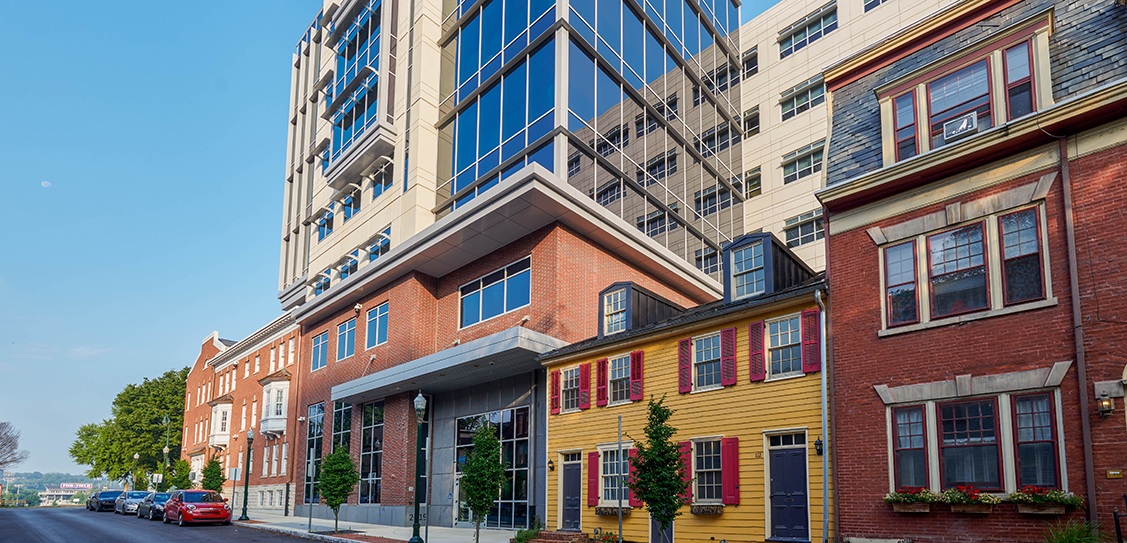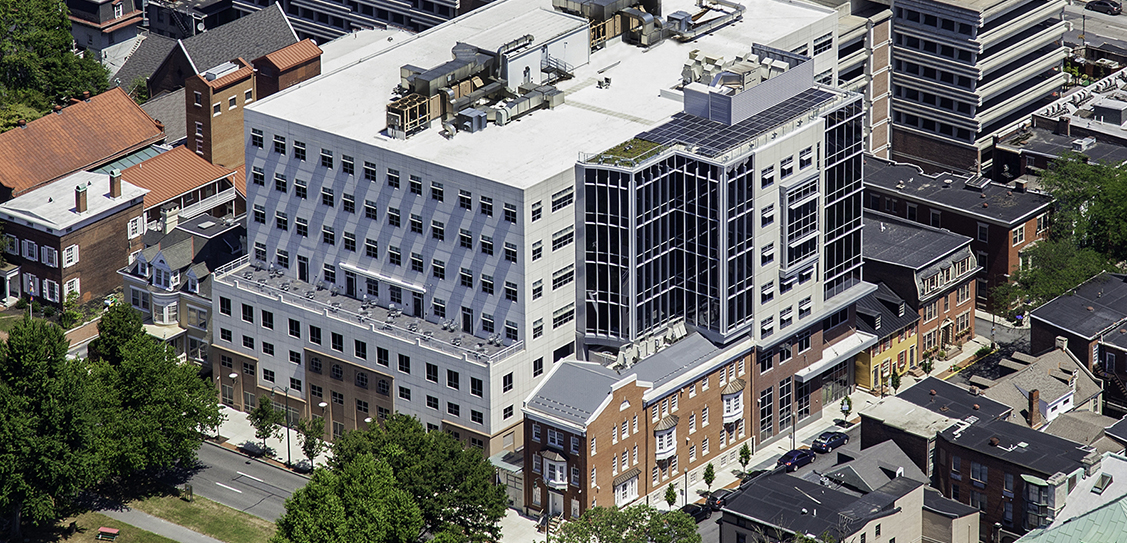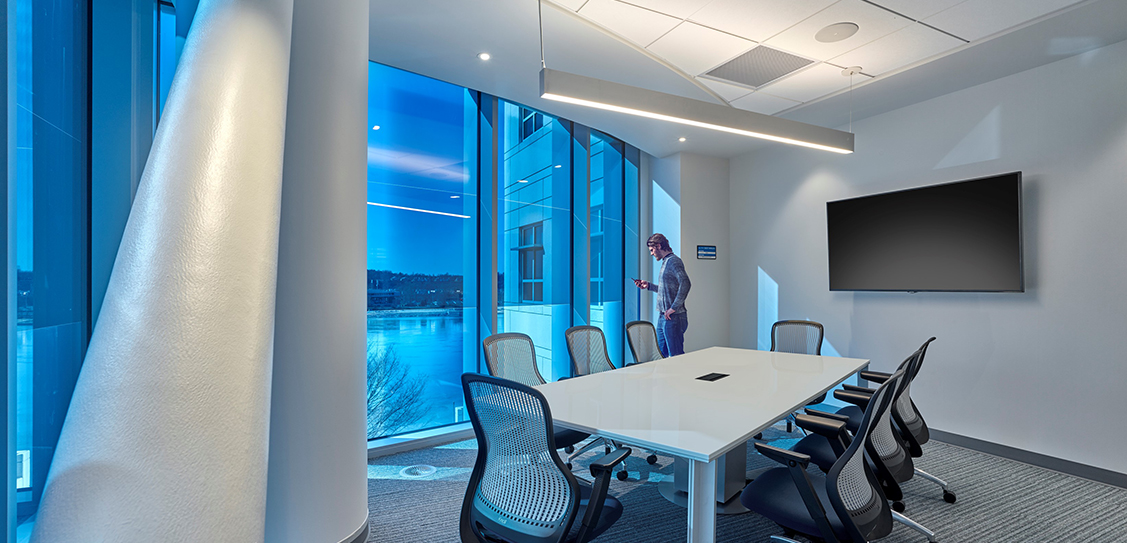When the Pennsylvania Housing Finance Authority (PHFA) were ready to expand their 2004 LEED Gold-certified headquarters in Harrisburg, they re-enlisted the same architect to surmount the challenges posed both by the landlocked urban site, a historic building component, and its energy conservation goals.
The resulting 39,705 sq ft expansion retrofitted the adjacent historic Hickok Mansion and constructed a new eight storey tower. Both the addition and renovation were designed to Passive House and LEED Platinum sustainability standards.
Since its completion in January 2020, the building has used 50% less energy than similar structures built to standard codes. PHFA also delivers 20% of its solar panel electricity production back to the city grid.
PHFA’s growth created disconnected departments and additional space was needed for new employees to continue their affordable housing mission. The agency’s urban headquarters was landlocked by deteriorating historic buildings and a small parking lot.
The dilapidated 1904 Hickok House adjacent to PHFA has had its rear non-historical addition razed, and its exterior restored. Its façade was too porous to support Passive House standards, so a new air-tight envelope was built “inside” the exterior wall.
The interior was retrofitted for a training centre and conference rooms. The new glass, precast concrete and brick tower blends old and new within the neighbourhood context. Its internal wall assemblies have insulated metal panels for controllable air-tightness, minimising thermal bridging.
The tower footprint was an impervious parking lot and the former non-historic Hickok House addition. The top four floors cantilever over the historic building and is crowned with a living roof and other natural materials. A new entrance for the Hickok House was constructed in the Front Street areaway and the original entrance was preserved. A translucent canopy of fritted laminated glass and exposed galvanised steel juxtaposes the new entrances cast stone.
PHFA purchased the adjacent deteriorating historic (c. 1904) house on Locust Street that is within a National Register Historic District. In 2011 it was listed as an endangered property by the Historic Harrisburg Association. Through numerous public workshops with Locust Street residents, the Historical Architectural Review Board and city officials, the design scheme proposing glass on the upper floors of the tower façade received overwhelming support.
High performance glass predominates the completed building, with a small section of precast panels uniting the existing and new structures visually. The tower site is flanked by the oldest clapboard homes in Harrisburg and great care was taken not to damage them during construction.
The new office addition utilises high amounts of energy with its elevator, equipment, appliances, computers and monitors. To meet LEED Platinum and Passive House criteria, multiple systems were integrated to offset energy consumption. An electrochromic curtain wall system of 129 panels reduces energy consumption through programmable tinting managing solar gain and light harvesting.
VRF mechanical systems provide comfortable and efficient heating and cooling zones while providing comfortable conditioned airflow. A photovoltaic system of 77 solar panels returns 20% of its generated energy to the utility grid. A living roof manages stormwater runoff, extending the roof life and reduces carbon dioxide emissions offsetting global warming.
Corporate office environments consume massive amounts of energy to function. PHFA’s addition reduces operational energy consumption and improves performances in energy savings, water efficiency, carbon dioxide emissions reduction, improved indoor environmental quality, and stewardship of resources. Through self-monitoring, PHFA has documented 50% less energy usage than a similar structure built to standard codes.
The tower occupies a constrictive urban parking lot and the area of the Hickok’s razed 1970s addition that was inappropriate and non-historical. To achieve maximum usable space, the tower’s top four floors cantilever over the 1904 building.
Two of the oldest clapboard homes in the city flank the eastern site boundary. Extreme care was taken not to damage them or their foundations. Numerous public workshops were held.
The scheme proposing glass on the upper portion of the tower received overwhelming support.
The Hickok House’s original entrance was not ADA compliant. It was closed and commemorated with a marker from the Historic Harrisburg Association. A new accessible entrance was created in the original Front Street areaway between PHFA’s buildings.
PHFA freely offers the preserved Hickok House and its conference rooms as a community meeting house to all local neighbourhood and non-profit groups. The new entrance also allows these groups to meet during off-hours, while maintaining PHFA’s security protocols.
A translucent canopy of fritted laminated glass and exposed galvanised steel juxtaposes the visual weight of the cast stone. Once inside, a linear skylight allows natural light into the entrance hallway
PA Housing and Finance Agency is collecting data on the performance of their addition. To date, the super-high energy efficiency of both additional structures uses EUI 30.0 kbtu/SF.
This is 46% less energy than a similar structure built to standard codes, with an EUI 56.3 kbtu/SF.
The Historic Harrisburg Association, Capitol Area Neighbors, the City of Harrisburg and PHFA worked together to find a way in which the Agency could expand, without demolishing both the Hickok Mansion and 110 and 122 Locust Street Clapboard homes around the corner. In doing so, the exterior of the Hickok Mansion has now been restored with new multi-paned PHIUS Certified windows and a water table treatment replaces the brick that had deteriorated.
A thermal barrier wall system was constructed inside of the original façade, addressing the inefficiency of the 1904 building's exterior envelope, preserving its historic authenticity, and mitigating thermal bridging. The original entrance didn’t meet ADA compliance, so a new entrance now exists between the two PHFA buildings. The first-floor multipurpose meeting is freely available to the community.
The 129 panels of electrochromic curtain wall system reduce energy consumption through programmable tinting, and managing solar loss and gain. Every five feet by 10 ft panel is segmented into three controllable zones. The eight inch insulated precast concrete wall and the curtain wall components were modeled for shading reduction factors.
An elegant stairway is located adjacent to the original headquarters, The suspended monumental glass stair encourages staff wellness as they circulate through the upper four floors of the tower. The base of the stair doubles as an impromptu collaboration space with its marble flooring and iconic seating.
Southwest-facing conference rooms are housed on the top four floors of the new tower, which cantilever over the historic Hickok House. The electrochromic glazed high-performance curtain wall system allows unobstructed views of the Susquehanna River and the city.



